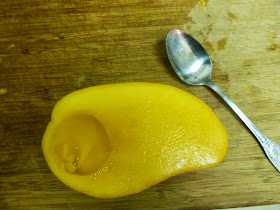Lychees aren't my favorite summer fruit, but they might just be my favorite summer travel snack.
A bag of lychees is a virtual cure-all for many summer travel grumbles.
- I'm hungry! (They're food, and will slake your hunger.)
- I'm thirsty and I don't have water! (Lychees are virtually bags of fruity water, and are so refreshing.)
- My beautiful peaches/plums/name your fragile fruit got bruised and now are disgusting! (It's hard to damage lychees; they're in the junior division of [link]armored fruit)
- I want some refreshing fruit but I don't have access to a refrigerator! (No problem. Lychees don't need refrigeration for a good long while.)
- I'm bored! (The process of peeling them, popping them in your mouth and spitting out the seed is better-than-middling entertainment.)
- Are we there yet? Are we there yet? (Ah, you got me on this one.)
I have long enjoyed lychees' cousins, rambutans and longans. Lychees are generally more widely available. I remember when you would need to go to Chinatown to buy lychees (as you still need to do for longans and rambutans), but lychees have made it as crossover hits. Not only can you buy lychee flavored liqueurs, coconut water and frozen yogurts, you can buy fresh lychees from non-Chinese vendors.
Some vendors emphasize the jungly look.

What hides beneath lychees' armor? A pearly white fruit with a shiny dark pit. To discover it, just use your fingernail to make a hole in the thin shell at its stem end, then peel off the shell entirely.

Typically my lychees end up as a bag of shells and pits, but they're versatile fruits and they dress up well. No reason not to invite them to the party! Here they are in good company (pineapple, grapes, melon, plums and berries) on a summer fruit platter.
Without their shells, lychees are excellent homebodies - and just as refreshing at home as they are on the road.




















